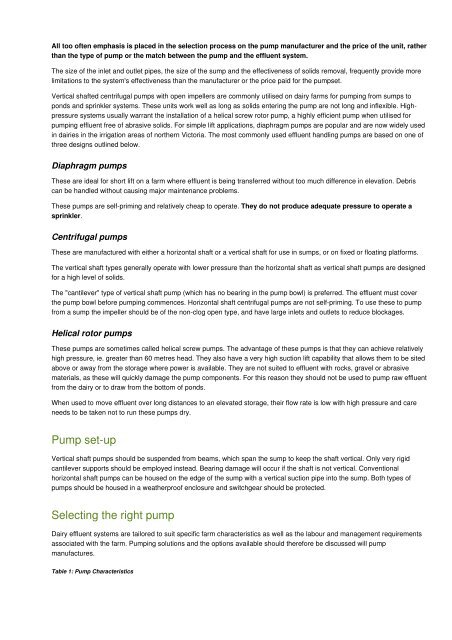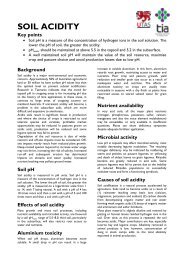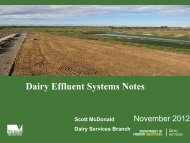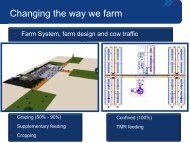Create successful ePaper yourself
Turn your PDF publications into a flip-book with our unique Google optimized e-Paper software.
All too often emphasis is placed in the selection process on the pump manufacturer <strong>and</strong> the price of the unit, ratherthan the type of pump or the match between the pump <strong>and</strong> the effluent system.The size of the inlet <strong>and</strong> outlet pipes, the size of the sump <strong>and</strong> the effectiveness of solids removal, frequently provide morelimitations to the system's effectiveness than the manufacturer or the price paid for the pumpset.Vertical shafted centrifugal pumps with open impellers are commonly utilised on dairy farms for pumping from sumps toponds <strong>and</strong> sprinkler systems. These units work well as long as solids entering the pump are not long <strong>and</strong> inflexible. Highpressuresystems usually warrant the installation of a helical screw rotor pump, a highly efficient pump when utilised forpumping effluent free of abrasive solids. For simple lift applications, diaphragm pumps are popular <strong>and</strong> are now widely usedin dairies in the irrigation areas of northern Victoria. The most commonly used effluent h<strong>and</strong>ling pumps are based on one ofthree designs outlined below.Diaphragm pumpsThese are ideal for short lift on a farm where effluent is being transferred without too much difference in elevation. Debriscan be h<strong>and</strong>led without causing major maintenance problems.These pumps are self-priming <strong>and</strong> relatively cheap to operate. They do not produce adequate pressure to operate asprinkler.Centrifugal pumpsThese are manufactured with either a horizontal shaft or a vertical shaft for use in sumps, or on fixed or floating platforms.The vertical shaft types generally operate with lower pressure than the horizontal shaft as vertical shaft pumps are designedfor a high level of solids.The "cantilever" type of vertical shaft pump (which has no bearing in the pump bowl) is preferred. The effluent must coverthe pump bowl before pumping commences. Horizontal shaft centrifugal pumps are not self-priming. To use these to pumpfrom a sump the impeller should be of the non-clog open type, <strong>and</strong> have large inlets <strong>and</strong> outlets to reduce blockages.Helical rotor pumpsThese pumps are sometimes called helical screw pumps. The advantage of these pumps is that they can achieve relativelyhigh pressure, ie. greater than 60 metres head. They also have a very high suction lift capability that allows them to be sitedabove or away from the storage where power is available. They are not suited to effluent with rocks, gravel or abrasivematerials, as these will quickly damage the pump components. For this reason they should not be used to pump raw effluentfrom the dairy or to draw from the bottom of ponds.When used to move effluent over long distances to an elevated storage, their flow rate is low with high pressure <strong>and</strong> careneeds to be taken not to run these pumps dry.Pump set-upVertical shaft pumps should be suspended from beams, which span the sump to keep the shaft vertical. Only very rigidcantilever supports should be employed instead. Bearing damage will occur if the shaft is not vertical. Conventionalhorizontal shaft pumps can be housed on the edge of the sump with a vertical suction pipe into the sump. Both types ofpumps should be housed in a weatherproof enclosure <strong>and</strong> switchgear should be protected.Selecting the right pump<strong>Dairy</strong> effluent systems are tailored to suit specific farm characteristics as well as the labour <strong>and</strong> management requirementsassociated with the farm. Pumping solutions <strong>and</strong> the options available should therefore be discussed will pumpmanufactures.Table 1: Pump Characteristics
















